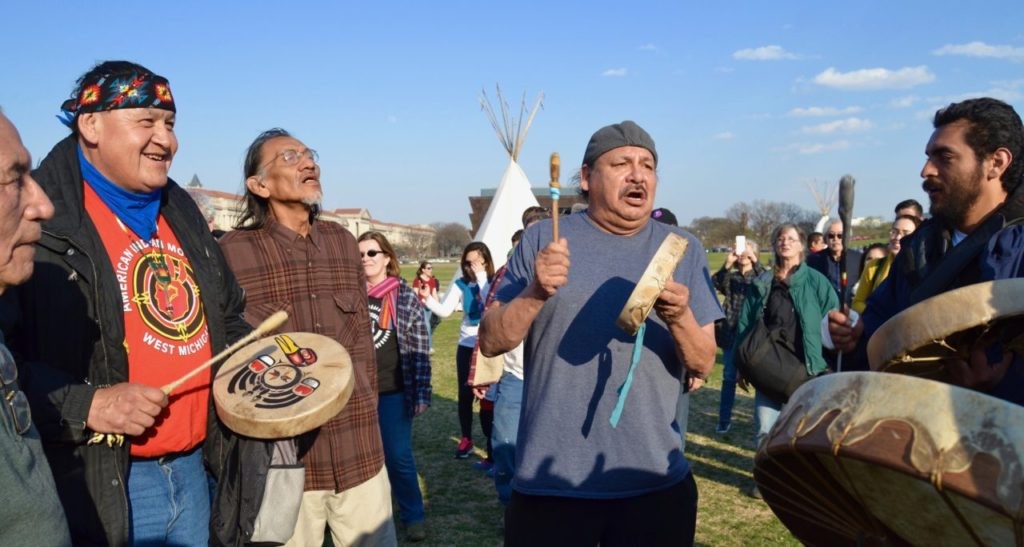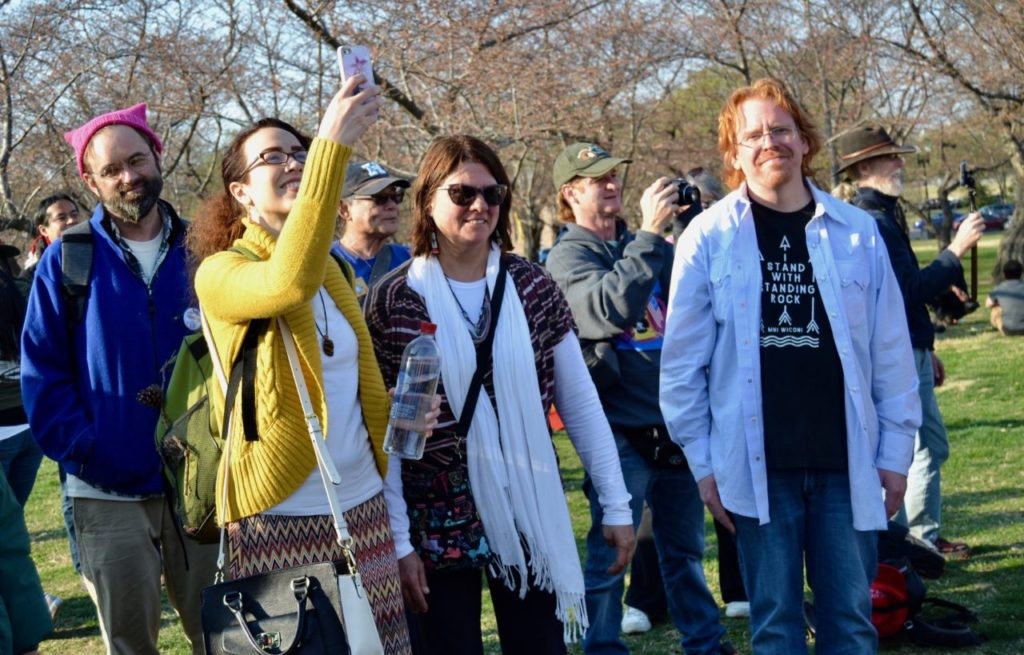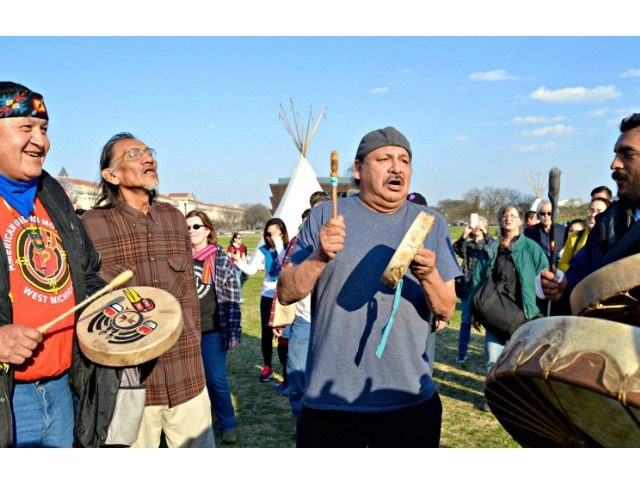In the shadow of the Washington Monument on Thursday, several tepees had been pitched, ceremonial dances and songs performed, and future activism plotted as a few hundred people protested the Dakota Access Pipeline.
The four-day encampment by the Standing Rock Sioux tribe, other Native Americans, and many who looked distinctly of European descent, culminated on Friday with a march to the White House.

Ceremonial song and dance were part of the protest against the Dakota Access Pipeline that took place this week in Washington, D.C.
This is the latest in a protest that has spanned many months over a nearly finished crude oil pipeline near the Standing Rock reservation in North Dakota and has included President Barack Obama putting the project on hold to review cultural sensitivities and environmental concerns and newly elected President Donald Trump ordering the project to move forward because a lengthy review by the federal government — and a federal court decision against a lawsuit to stop it — were in the books.
Breitbart News visited the encampment to talk with people participating and discovered that the conflict between the protesters and those in favor of developing domestic energy resources in the United States may be less a matter of malicious intent and more about the flow of misinformation.
“I came to support the movement of Standing Rock and to protest against a president using an executive order to further his financial interests at the expense of tribal sovereignty and water,” Red Wollf Pope, of the Shoshone and Klickitat tribes, told Breitbart News.
Pope also said Trump had not divested his financial interest in Energy Transfer Partners — the company developing the pipeline.
Lehi Thunder Voice Eagle Sanchez of the Navajo tribe in Arizona said that oil is an “outdated resource” and said the pipeline threatens the Sioux’s water supply and that even in the nation’s capitol it’s not safe to drink water from the tap.
“Even now here in the city, it’s not recommended that we drink the tap water,” Sanchez said, adding that the fluoride in the water is not good to drink, but is used because it’s a resource that’s abundant and so exploited, much like oil.
“Water is a human right,” Sanchez said. “Clean water should be available to everybody.”
“We are calling on all our Native relatives and allies to rise with us,” Dave Archambault, the chairman of the Standing Rock Sioux tribe, said in a report by PBS News Hours. “We must march against injustice.

Those who are not Native American but call themselves “allies” of the protestors also took part in the D.C. protest
“Native nations cannot continue to be pushed aside to benefit corporate interests and government whim,” Archambault said.
Here are some facts to consider:
- On Trump’s financial interest in the pipeline: “President-elect Donald Trump sold off his shares of Energy Transfer Partners, the owner of the $3.7 billion Dakota Access pipeline that has become the focus of protests by Native American and environmental groups, according to his spokeswoman Hope Hicks,” the Washington Post reported in November of 2016. “Trump’s share, which in a May 2015 disclosure was listed at between $500,000 and $1 million, had fallen to less than $50,000 by the time he sold it in the summer of 2016, according to a disclosure earlier this year.”
• On fluoride in drinking water: “Drinking fluoridated water keeps teeth strong and reduces cavities (also called tooth decay) by about 25% in children and adults,” according to the Centers for Disease Control and Prevention. “By preventing cavities, community water fluoridation has been shown to save money for families and for the US health care system.”
“Community water fluoridation is the most cost-effective way to deliver fluoride to people of all ages, education levels, and income levels who live in a community,” the CDC reports. “Most water has some fluoride, but usually not enough to prevent cavities. Community water systems can add the right amount of fluoride to the local drinking water to prevent cavities.
“Community water fluoridation is recommended by nearly all public health, medical, and dental organizations,” the CDC reports. “It is recommended by the American Dental Association, American Academy of Pediatrics, US Public Health Service, and World Health Organization.”
On the Dakota Access pipeline, which will carry as many as 570,000 barrels a day of shale oil 1,170 miles from western North Dakota to pipeline connections in Illinois:
▪The Dakota Access is one of the most technologically advanced and safest pipelines ever built. It is entirely underground and surpasses federal safety requirements.
▪The pipeline does not encroach or cross any land owned by the Standing Rock Sioux Tribe.
▪The Dakota Access Pipeline is entirely underground and will cross under Lake Oahu at a minimum depth of 95 feet below the riverbed.
▪The Dakota Access Pipeline does not endanger water; the Standing Rock Sioux water inlet by early 2017 will be moved to a location more than 70 miles away from the pipeline.
On what the feds did to review the pipeline: “In developing the route, the United States Army Corps of Engineers alone held 389 meetings with 55 tribes regarding the Dakota Access project. In addition, the U.S. Army Corps reached out to the Standing Rock Sioux Tribe nearly a dozen times to discuss archaeological and other surveys conducted before finalizing the Dakota Access route,” according to the pipeline fact sheet.
On fossil fuels and American energy: “Three fossil fuels—petroleum, natural gas, and coal—have provided more than 80% of total U.S. energy consumption for more than 100 years,” according to the federal Energy Information Administration. ‘In 2015, fossil fuels made up 81.5% of total U.S. energy consumption, the lowest fossil fuel share in the past century. In EIA’s Annual Energy Outlook 2016 Reference case projections, which reflect current laws and policies, that percentage declines to 76.6% by 2040.”

COMMENTS
Please let us know if you're having issues with commenting.